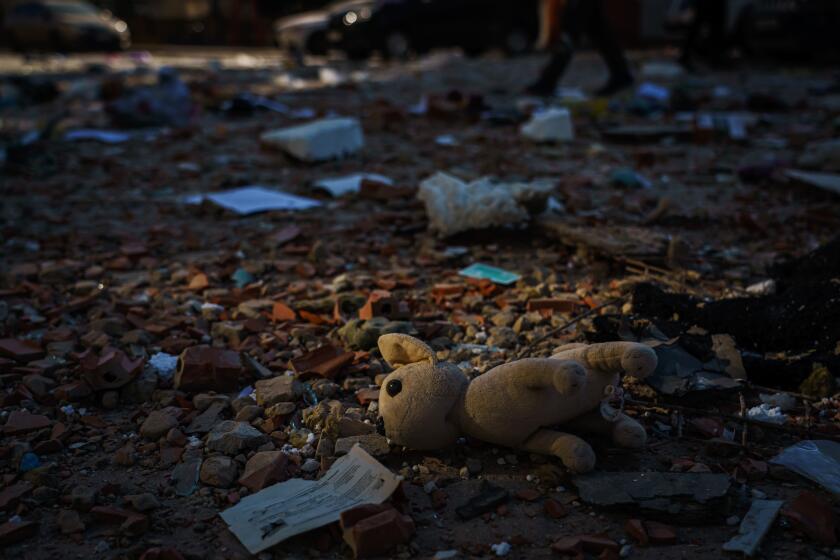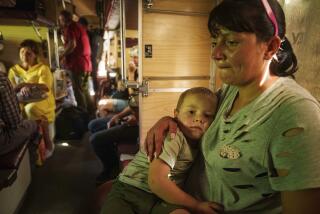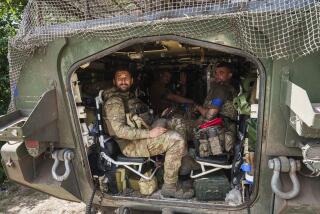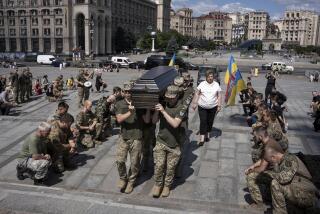
- Share via
IRPIN, Ukraine — The last minutes before the train pulled out were chaos: A mass of people pushed toward the carriage doors as uniformed men carrying machine guns screamed at slow-moving babushkas, teary-eyed girls and the many, many children straggling onto the platform.
No men were allowed. One managed to slip past the guards with his dog in tow, but a crush of soldiers pounced on him. They chased him, raised their rifles at his dog and shoved him onto the tracks. A soldier grabbed the phone of a bystander filming the fracas, smashed it on the ground, then stomped on it twice.
Finally, slowly, the train began to move toward Kyiv. A woman glued her face to the carriage window, weeping and waving goodbye to someone on the platform. After the train was gone, those who remained were still for a moment, then walked back to the street in silence.
It had taken a little over a week for Russia’s war to come to Irpin, transforming what was a charming suburb northwest of the Ukrainian capital into an eerie place of cracked windows, mortar-gouged streets, smoke-darkened skies, grief and dread.
The day before, Ukrainian and Russian delegates had negotiated an agreement to set up so-called humanitarian corridors, allowing passage to safety for those who found themselves in the middle of the fighting. But authorities weren’t waiting for such plans and had already told civilians to evacuate.

Residents needed little convincing. Irpin, a city of some 60,000 named after the eponymous river, sits next to the capital, a jaunt down the highway to get to downtown Kyiv. Earlier in the week it was still a mostly placid walk down its main thoroughfare to Bucha, the next town to the north. The fighting was there, or in Antonov Airport just above that, where a miles-long Russian column of tanks and armored trucks came ever closer. On Tuesday, most of the people dragging their belongings to the blast-severed Irpin bridge had been from those towns.
But Thursday night the shelling grew far closer, said Luba Lipko, a 27-year-old designer assistant joining the steady stream of residents carefully stepping across a makeshift bridge across the riverbed.
“Now it’s very dangerous. It felt like we were going to die,” she said, her blue-green eyes widening. “My mom’s friend — she lives nearby — called and she saw Russian tanks near us at night.”
By the afternoon, Ukrainian forces appeared back in control of Irpin, but a succession of booms, bangs and staccato bursts left one wondering how long they could hold out, and if they couldn’t, how long would it be before Russians entered Kyiv, where people were also beginning to flee.
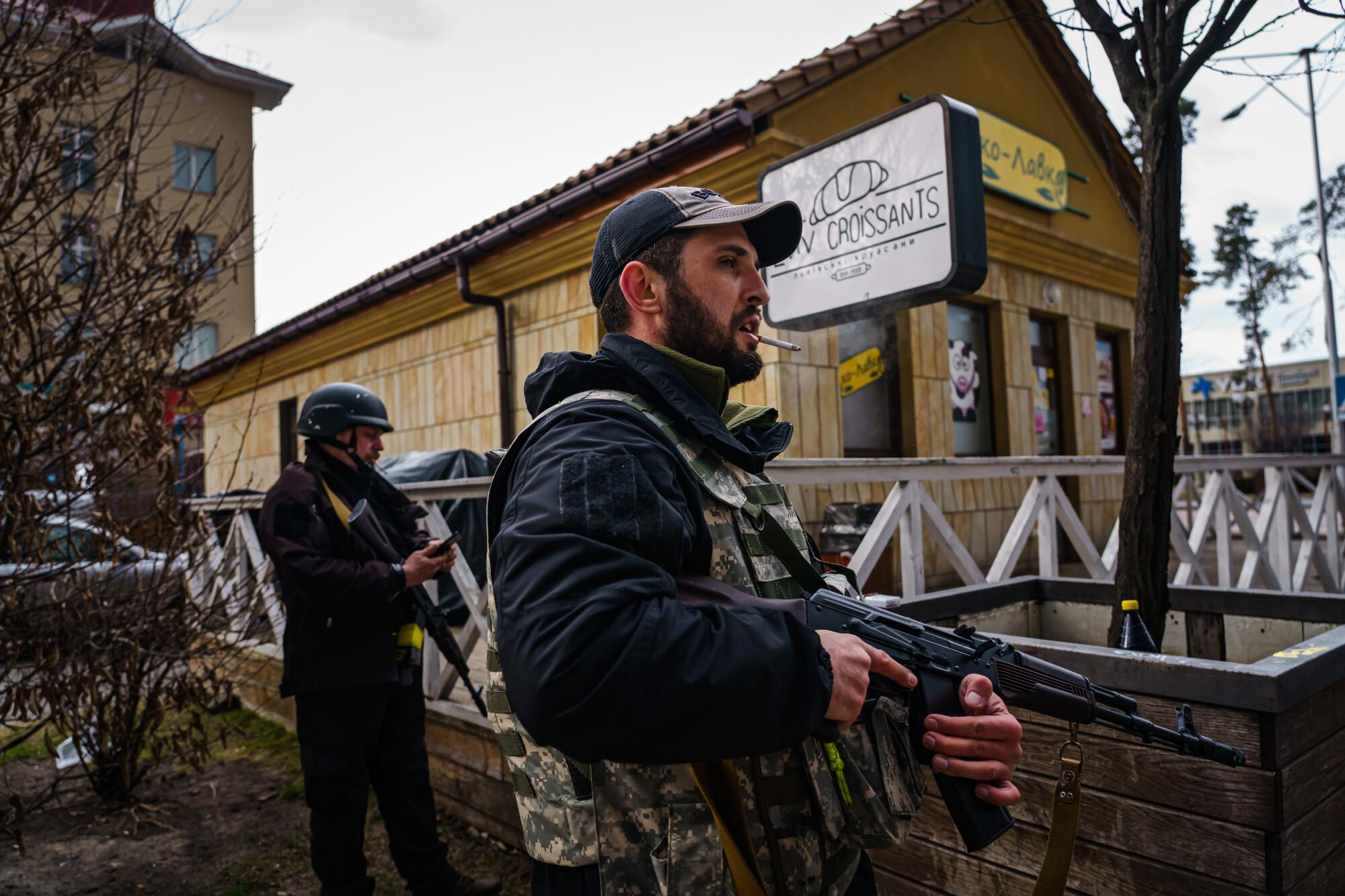
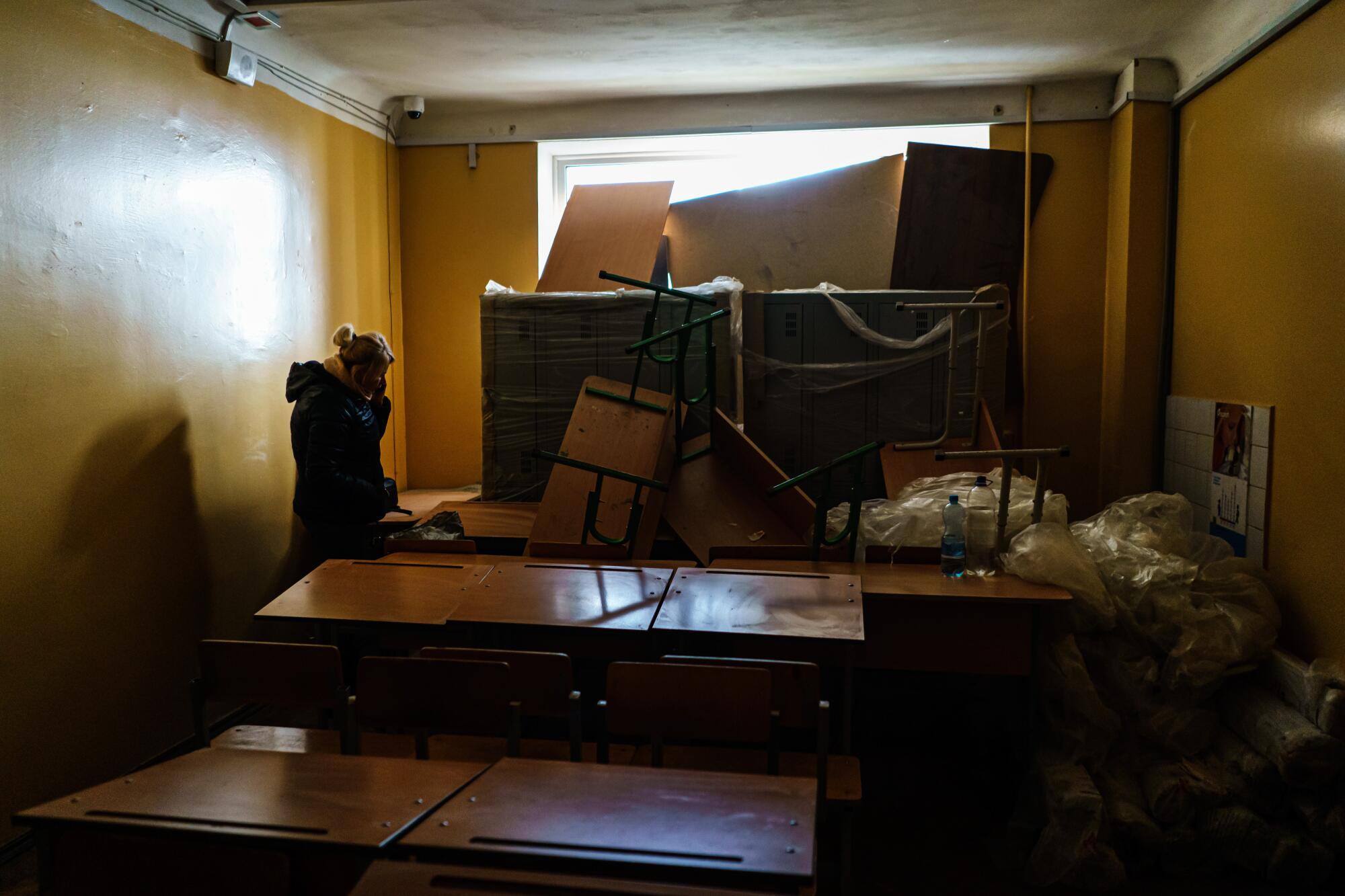
Video on social media (its veracity was confirmed by open-source experts) showed a Russian Su-25 warplane streaking over an Irpin neighborhood. It dropped a delayed-fuse bomb on a house, which blew up moments later. It could have been the one now burning in the middle of town, but it was unclear if it was from that or another shell. And in the distance, somewhere near Bucha, Hostomel or Borodyanka, four large plumes of smoke rose and combined, turning the air sour in Irpin.
“Unfortunately, my brother is here, my boyfriend is here,” Lipko said. Her mother wanted to stay, but was finally persuaded to leave. Relatives in Poland told them to come “and at least save our own lives.”
Lipko hoped to get to Lviv in western Ukraine or to Poland. She still didn’t know. Before she walked away, she exhorted a reporter to “explain to the Russians.”
“Explain that it’s them, not us, who is attacking,” she said, mentioning her relatives in Russia who believe Moscow’s assertion that the strikes against civilian areas are the work of Ukrainian nationalists. She navigated past the makeshift barriers the Ukrainians set up on this side of the bridge: the now-ubiquitous old tires, but also logs laid out into the street, filling the air with the bracing scent of cut wood.
The men who stayed behind in Irpin, like Roman Muromtsev, 32, promised a vigorous defense.
He wore fluorescent orange-speckled Nike sneakers under his fatigues, standing by a corner of the commercial strip near the Irpin train station. A toy store advertising Legos was behind him. He had worked in the United Arab Emirates in IT and had moved to Kyiv.
“I work in the capital. Now I’m here to defend it,” he said, his eye trained up the road to the north. Near him, the dogs on the sidewalk by the station barked every time they heard a blast, which is to say they barked incessantly. A Red Cross vehicle made a U-turn and gunned the engine toward the city’s southern exit — for refueling and resupply, the driver said.
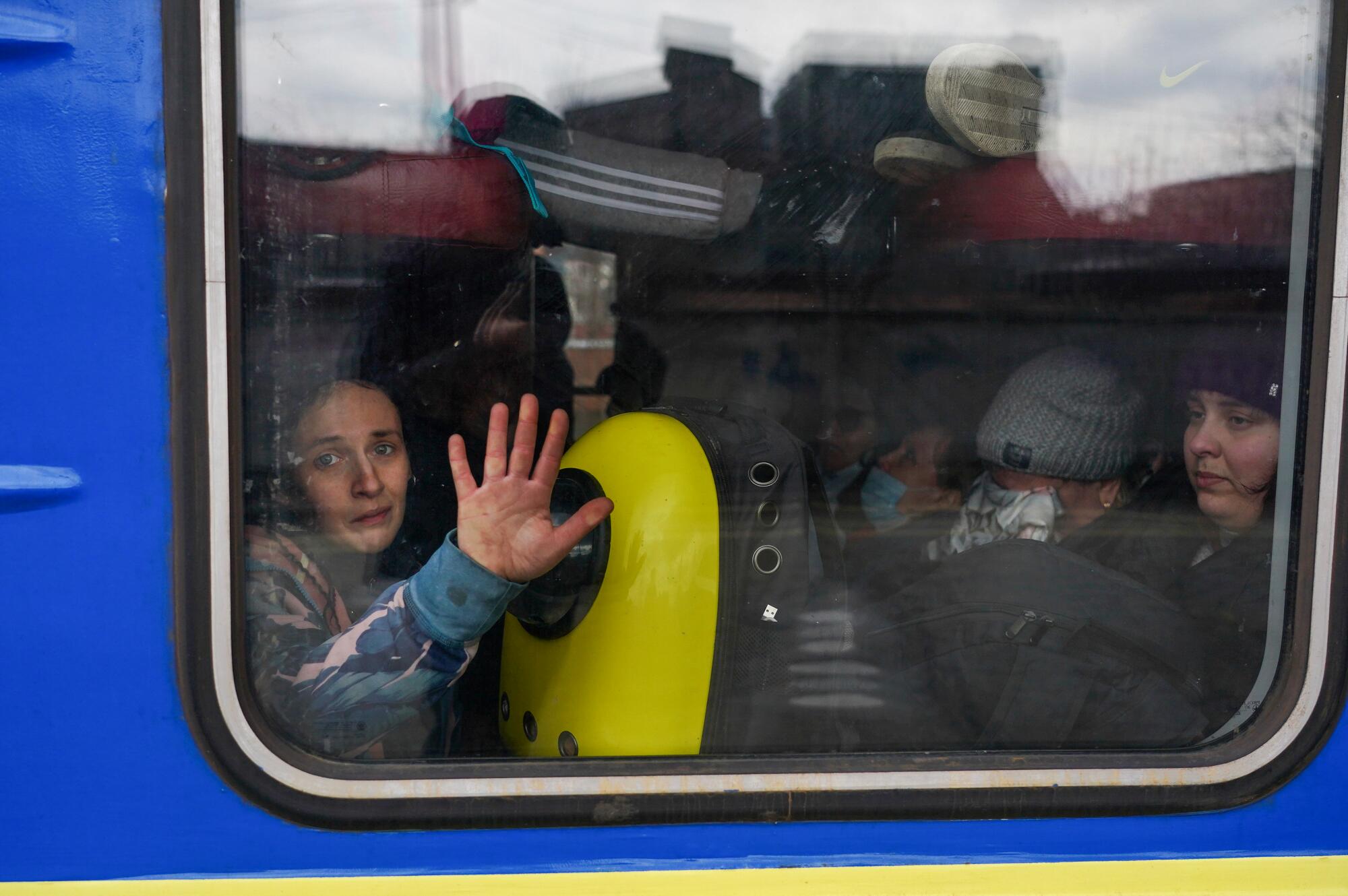
There wouldn’t be another train for hours, so residents had organized a sort of mass carpool shuttle. Some families were taken to the river crossing, where they would have to find their way on foot; others were driven to a nearby roundabout to take a circuitous route to the capital — one with the chance of running into Russian troops. A fair amount chose the former, dumping their vehicles before the broken bridge and crossing to relative safety on the other side.
Many remained in the city, trapped in the agonizing calculations that had increased in intensity every night since Feb. 24: How much could you bear to leave behind, and what price would you pay for that extra time?
Ukrainians have been forced to flee their homes or fight back as Russian forces attack their cities. These photos and maps tell the story.
Yura Ponomarenko, a 26-year-old who wanted to serve in the army but was rebuffed because he was too inexperienced, was busing medicines and food supplies to people in Bucha.
He almost reached the checkpoint at the Giraffe Mall at Irpin’s northern edge when Ukrainian soldiers leaped out of their position on the sidewalk and frantically waved the car down. The Russians were there. Ponomarenko quickly turned around.
He made a call, gave up on getting to Bucha and drove to School No. 3. He parked his car in the driveway and got out to meet Stas Federovo, the 31-year-old principal of the school who was also the head of Ukraine’s federation for horting, a kind of martial arts.
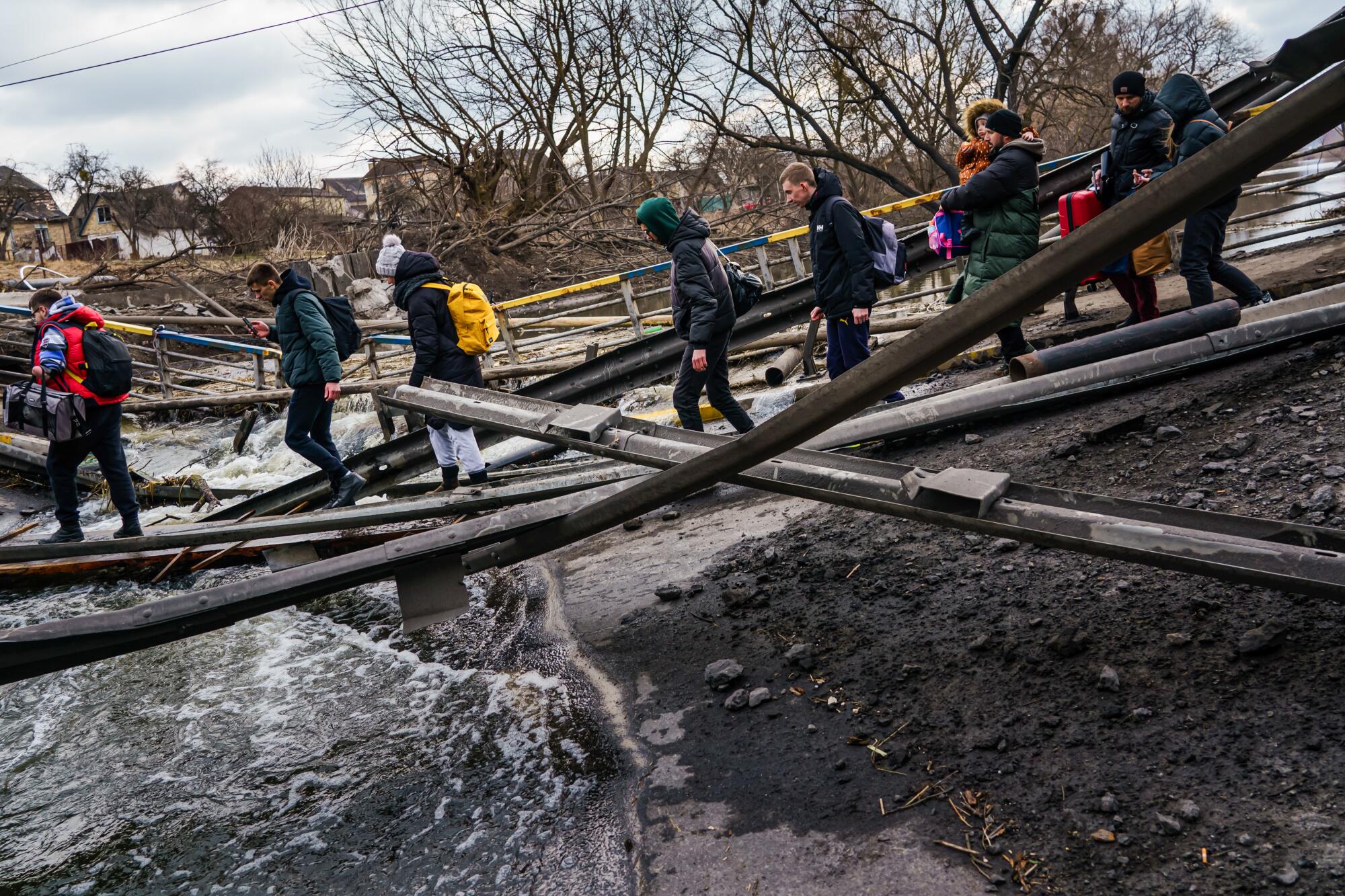
The shuttered school, Federovo said, had been turned into a shelter for those who wanted to stay in the city, numbering some 300 people here. He led a visiting reporter to the basement, past concrete-dusted floors and tarpaulins to reveal mattresses on pallets and people blinking rapidly when he turned on his smartphone light (there was no electricity). Near one of them was a box of “Amazing Writer” pencils and a gun.
Federovo was supposed to take part in the European horting championship this month. He shrugged with a rueful smile. “I guess I won’t go now,” he said.
A shell landed nearby at that moment, sending everyone dashing to the basement. No one could see where it hit, but it was enough to rattle 43-year-old Oxana Romanschuk. She got out and started to cry.
She and her family soon left, cramming their things into three cars and screeching down the road away from the school gates. Romanschuk, along with two other women — Natalya and her daughter Victoria — cried the whole time out of Irpin.
By the late afternoon, the exodus was full-on. Zoya Ilnitsky, who along with her husband, Father Roman, ran a church that had housed some 400 people in the last few days, was standing near bins of apples, croissants and biscuits near the entrance.
“Last night we had 100 kids. The convoy that was supposed to leave turned back,” she said. Now it was 50, and more were leaving by the minute. Others would soon take their place.
Ilnitsky was smiling brightly, exuding a welcoming, calming presence that seemed to hint that nothing was out of the ordinary, despite the craziness around her.
But the spell broke for a moment when she was asked when she would leave.
“Not yet,” she said. Her eyes winced over a tight smile.
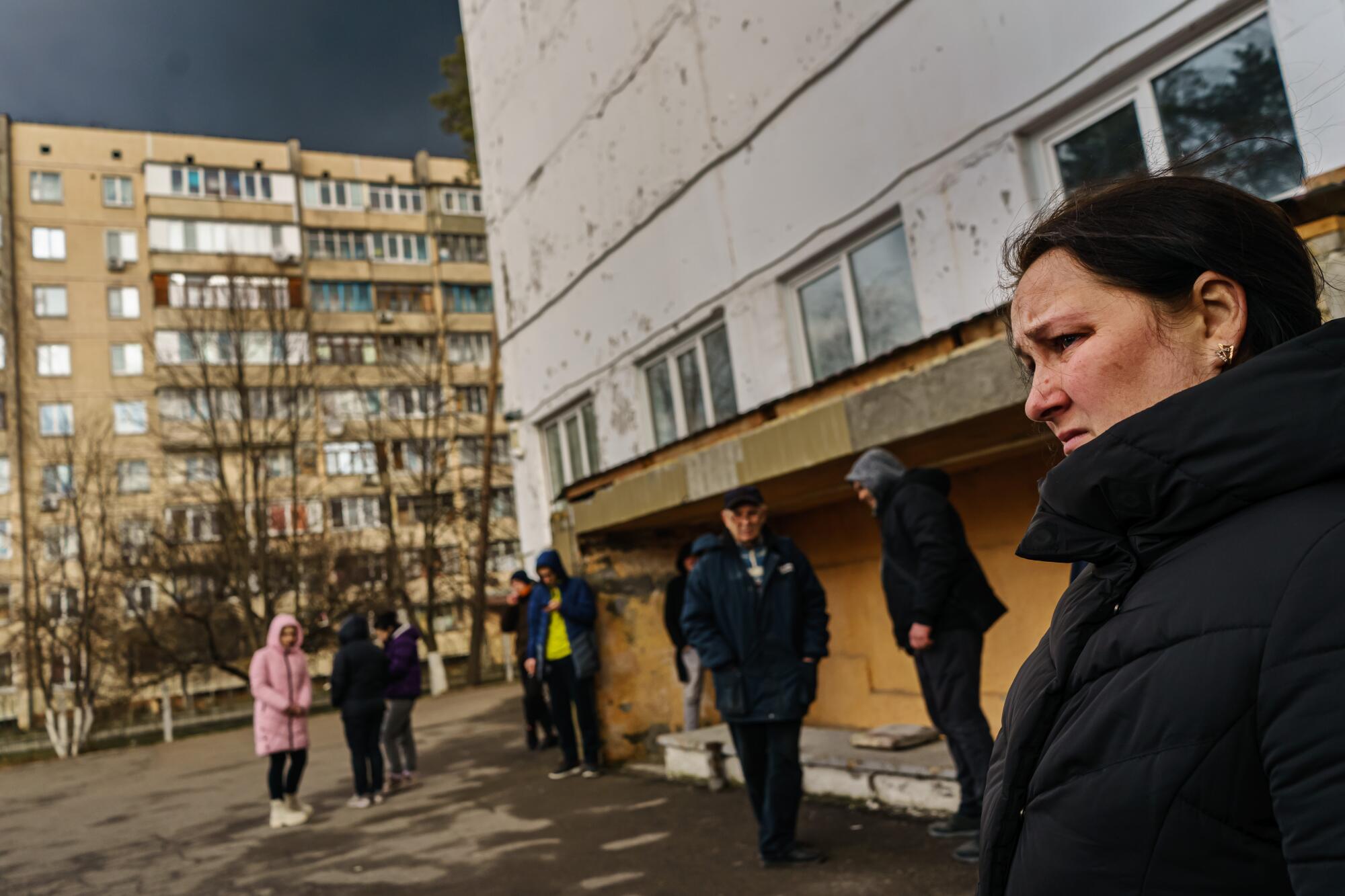
More to Read
Sign up for Essential California
The most important California stories and recommendations in your inbox every morning.
You may occasionally receive promotional content from the Los Angeles Times.
